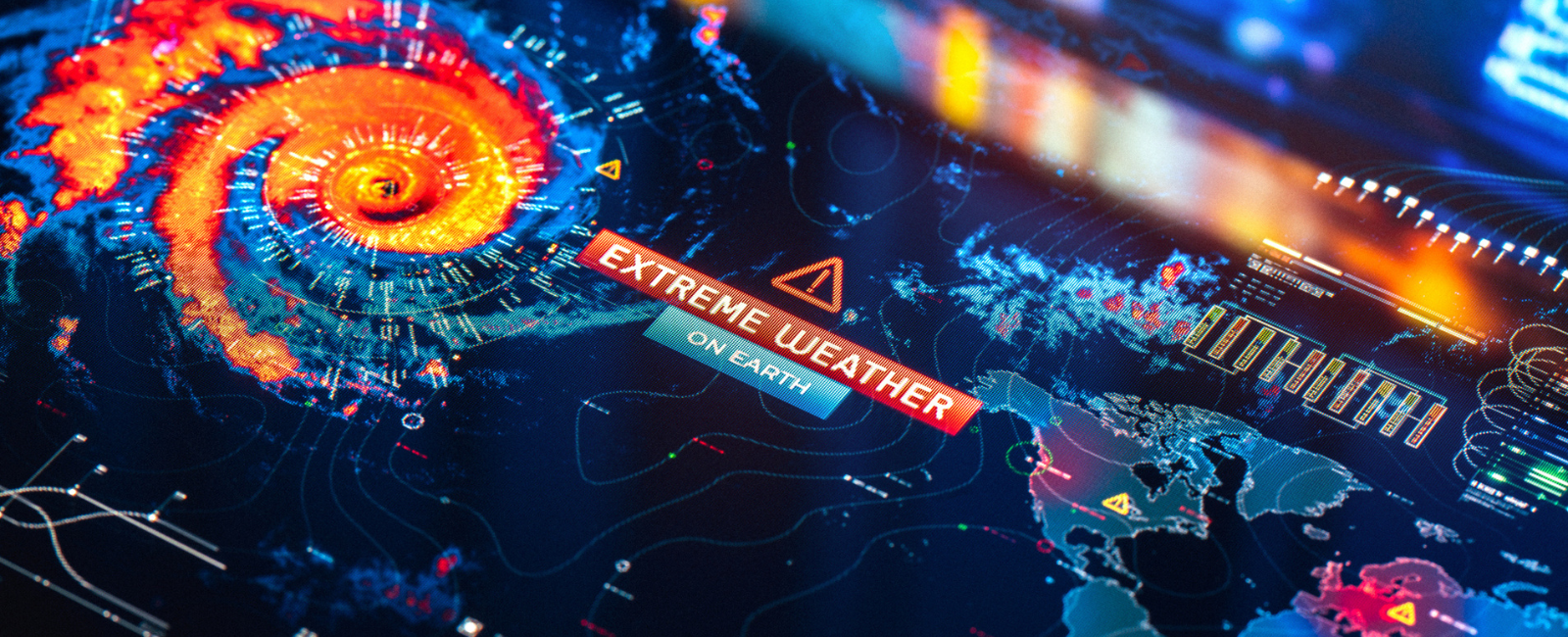Technology Used to Prepare and Respond to Weather Events and Other Natural Disasters

From weather reporters to the team that flies airplanes through hurricanes, one thing these professionals have in common is the use of the latest technology—to help prepare ahead of time and respond to those in need after devastating events.
- Drones and unmanned aircraft systems (UAS)
- Data capture and data visualization technology
- Robotics
- Building information modeling (BIM)
- Online communication technology
- Artificial intelligence (AI)
- 3D printing
Drones and Unmanned Aircraft Systems
During Hurricane Milton in October of 2024, state officials with the North Carolina Department of Transportation’s Division of Aviation deployed drones and unmanned aircraft systems (UAS) to survey roads, bridges and other infrastructure, flying more than 200 missions in one week alone. “UAS allow us to see in better detail where water is going and which areas will be impacted by flooding, which is vital information to have during a crisis event,” said Jamie Dyer, a geosciences professor at Mississippi State and associate director at the university’s Northern Gulf Institute. “Additionally, the data we collect will improve the river forecasting models that local, state and federal officials rely on.”
Over the past few years, autonomous sail drones have been used to collect critical data such as wave heights and storm intensity. NOAA (National Oceanic and Atmosphere Administration) has tested and deployed marine drones to view Hurricane Milton inside and out. A video shared by Saildrone showed that the wave height reached 28.12 feet, and that wind gusts were as strong as 75.95 mph, 40 nautical miles from the center of the storm.
Drones, unmanned aerial vehicles (UAVs) and UAS have been increasingly deployed after natural disasters. Equipped with thermal cameras, they can quickly locate stranded or injured civilians, ensuring precise deployment of emergency responders. In treacherous conditions, they deliver essential supplies like food, water, blankets and medical aid. Using data capture technology, UAVs and UAS can collect timestamped data to assess the scale and impact of these disasters, mapping out everything from demolished structures to debris flow to inform long-term recovery efforts.
Data Capture and Data Visualization Technology
Remote sensing monitors an area’s physical characteristics without the need for direct contact, using satellites and aircraft to measure a region’s reflected and emitted radiation to gain useful information about large areas of land, movement of clouds and change in the earth’s temperature or topography of the ocean. Remote sensing helps predict the scale of natural disasters, enabling preparedness strategies. It also identifies hazard zones during events like wildfires for prioritized evacuation and emergency response.
NASA astronauts on board the International Space Station, a key part of disaster management teams, have used the remote sensing technology available to them to provide maps, images and data to help manage the flooding, power outages and rainfall levels during hurricanes and other weather events.
Geographic information system (GIS) is a technology that analyzes geographic data using satellite imagery, weather data and sensor networks. It first predicts whether heavy rainfall and flooding are likely to lead to disaster events like mudslides and debris flow. Secondly, it provides real-time data on the affected area for population density and evacuation routes for effective response and recovery efforts. Lastly, during the aftermath, it compares pre- and post-disaster data to assess impact and estimate financial losses, aiding recovery efforts and prioritizing the communities most affected.
Robotics
Robotics are also used for search and rescue. After natural disasters, accessing injured or trapped civilians can be both difficult and dangerous. Search and rescue robots, like DEEP Robotics’ X30 quadruped robot dog, are designed to quickly traverse and survey complex terrains and extreme environments, locate and treat survivors and carry medical equipment such as oxygen tanks. These robots also collect disaster data, detect dangerous materials and substances, and can manipulate objects to pave the way for human responders.
Building Information Modeling (BIM)
Disaster-resilient architecture relies on building information modeling (BIM) and other technologies and techniques, to minimize damage and the loss of life during disasters. This applies to buildings, public transit, power systems and communication services, to guarantee their resistance to floods, fires and earthquakes. For example, seismic retrofitting strengthens a building's durability to earthquake shaking, while impermeable barriers and raised structures protect against flooding.
Online Communications Technology
Online communication platforms like X (formerly Twitter), Instagram and Facebook have revolutionized disaster response by allowing real-time documentation and tracking of events, enabling communities to stay connected and providing critical information to first responders. Cell phones often maintain internet connectivity when other devices fail, allowing local officials to use social media to share updates on evacuation routes, road closures and help areas.
Artificial Intelligence (AI)
A research team from MIT has developed a deep learning system that detects natural disasters using social media images. Trained on 1.7 million photographs, it can analyze, filter and identify real-world disasters. Deep learning is a method in artificial intelligence (AI) that teaches computers to process data in a way that is inspired by the human brain.
AI now plays an important role in disaster mitigation, forecasting events like hurricanes, tornadoes, floods and earthquakes. It analyzes vast geographic data to identify patterns and anomalies indicating imminent disasters, while supporting response planning by predicting the intensity, path and impact of events. As storms are becoming more common and more severe, AI scientist Zhe Jiang said, "We are really racing with time to develop AI technologies faster.”
3D Printing
Even technologies like 3D printing can aid in disaster recovery. Large-scale natural disasters can obstruct roads and prevent first responders from delivering essential supplies. 3D printing addresses this by quickly producing critical items on demand from local materials. After the 2020 Haiti earthquake, for example, 3D printing was used to create umbilical cord clamps, surgical instruments and finger splints. It can also quickly produce durable shelters on a large scale.

Related articles that may be of interest to you:
The History of the Internet: Resources for Middle Grade Teachers
Hispanic Inventors and Tech Innovators Throughout History
History of Tech at the Olympic Games
Sources:
Time: How Meteorologists Are Using AI to Forecast Hurricane Milton and Other Storms by Andrew R. Chow
UniverseToday.com NASA Reveals the Mind-Boggling Scale of Hurricane Milton seen from Space by Mark Thompson
NASA Earth Observatory: Fuel for Hurricane Milton
Flying magazine: Responders Turn to Drones Amid Hurricane Recovery by Jack Daleo
KTVU Fox 2: Watch: Alameda-based company captures stunning drone video of Hurricane Milton by Kayla Galloway and Jana Katsuyama
Innovation & Tech Today: Building Back Better: Expert Insights on Rebuilding After Hurricane Milton by Lindsey Feth
Thomas Publishing Company: Types of Natural Disaster Technology by Laura Ross
Accruent: What is Building Information Modeling? (BIM)
National Weather Service: Data / Forecast Software
DEEP Robotics: Emergency Mission 2024: DEEP Robotics’ Robot Dog Scouts for Fire and Explosion Hazards
ScienceDirect: Managing natural disasters: An analysis of technological advancements, opportunities, and challenges by Moez Krichen, Mohamed S. Abdalzaher, Mohamed Elwekeil, and Mostafa M. Fouda
Photo: iStock

